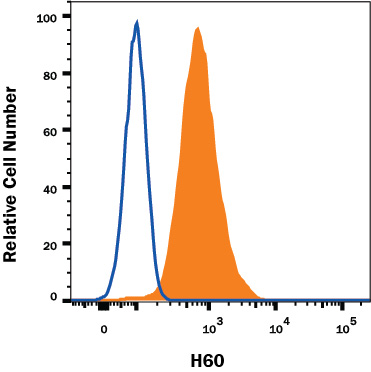Mouse H60 Antibody Summary
Asp30-Gln212
Accession # Q3TDZ7
Applications
Mouse H60 Sandwich Immunoassay
Please Note: Optimal dilutions should be determined by each laboratory for each application. General Protocols are available in the Technical Information section on our website.
Scientific Data
 View Larger
View Larger
Detection of H60 in RAW 264.7 Mouse Cell Line by Flow Cytometry. RAW 264.7 mouse monocyte/macrophage cell line was stained with Rat Anti-Mouse H60 Monoclonal Antibody (Catalog # MAB1155, filled histogram) or isotype control antibody (Catalog # MAB0061, open histogram) followed by anti-Rat IgG PE-conjugated Secondary Antibody (Catalog # F0105B). View our protocol for Staining Membrane-associated Proteins.
Reconstitution Calculator
Preparation and Storage
- 12 months from date of receipt, -20 to -70 °C as supplied.
- 1 month, 2 to 8 °C under sterile conditions after reconstitution.
- 6 months, -20 to -70 °C under sterile conditions after reconstitution.
Background: H60
H60 was originally described as an immunodominant histocompatibility antigen that is expressed in BALB mice but not in B6 mice. More recently it was reported to function as a ligand for mouse NKG2D, an activating receptor found on NK cells, on some T cell subsets, and on stimulated macrophages. H60 shares approximately 25 percent amino acid identity with the Rae-1 family, a small group of proteins that also function as ligands for mouse NKG2D. H60 and the Rae-1 proteins are distantly related to MHC class I proteins, but they possesses only the alpha 1 and alpha 2 Ig-like domains, and have no capacity to bind peptide or interact with beta 2‑microglobulin. The genes encoding these proteins are not found within the Major Histocompatibility Complex on mouse chromosome 17, but rather map to mouse chromosome 10. Unlike the GPI-linked Rae-1 proteins, H60 appears to be anchored to the membrane via a hydrophobic transmembrane segment. H60 transcripts were found in embryonic tissue, in spleen, and in some transformed cell lines. Transcripts were also observed in mouse skin cells after exposure to carcinogens. Binding of H60 to NKG2D results in the activation of cytolytic activity and/or cytokine production by the NKG2D-expressing effector cells. Ectopic expression of H60 on mouse tumor cell lines resulted in the in vivo rejection of the tumors (1‑6).
- Malarkannan, S. et al. (1998) J. Immunol. 161:3501.
- Diefenbach, A. et al. (2000) Nature Immunol. 1:119.
- Cerwenka, A. et al. (2000) Immunity 12:721.
- Cerwenka, A. et al. (2001) Proc. Natl. Acad. Sci. USA 98:11521.
- Diefenbach, A. et al. (2001) Nature 413:165.
- NKG2D and its Ligands, www.RnDSystems.com.
Product Datasheets
Citations for Mouse H60 Antibody
R&D Systems personnel manually curate a database that contains references using R&D Systems products. The data collected includes not only links to publications in PubMed, but also provides information about sample types, species, and experimental conditions.
5
Citations: Showing 1 - 5
Filter your results:
Filter by:
-
Visualizing the Rapid and Dynamic Elimination of Allogeneic T Cells in Secondary Lymphoid Organs
Authors: Y Kanda, A Takeuchi, M Ozawa, Y Kurosawa, T Kawamura, D Bogdanova, H Iioka, E Kondo, Y Kitazawa, H Ueta, K Matsuno, T Kinashi, T Katakai
J. Immunol., 2018-06-20;0(0):.
Species: Mouse
Sample Types: Whole Cells
Applications: Flow Cytometry -
NKG2D-NKG2D Ligand Interaction Inhibits the Outgrowth of Naturally Arising Low-Grade B Cell Lymphoma In Vivo
J Immunol, 2016-05-02;196(11):4805-13.
Species: Mouse
Sample Types: Whole Cells
Applications: Flow Cytometry -
NKG2D-dependent activation of dendritic epidermal T cells in contact hypersensitivity.
Authors: Nielsen M, Dyring-Andersen B, Schmidt J, Witherden D, Lovato P, Woetmann A, Odum N, Poulsen S, Havran W, Geisler C, Bonefeld C
J Invest Dermatol, 2015-01-29;135(5):1311-9.
Species: Mouse
Sample Types: Tissue Homogenates, Whole Cells
Applications: Flow Cytometry, Western Blot -
Bortezomib treatment and regulatory T-cell depletion enhance the antitumor effects of adoptively infused NK cells.
Authors: Lundqvist A, Yokoyama H, Smith A, Berg M, Childs R
Blood, 2009-02-06;113(24):6120-7.
Species: Mouse
Sample Types: Whole Cells
Applications: Flow Cytometry -
A role for activation-induced cytidine deaminase in the host response against a transforming retrovirus.
Authors: Gourzi P, Leonova T, Papavasiliou FN
Immunity, 2006-06-01;24(6):779-86.
Species: Mouse
Sample Types: Whole Cells
Applications: Flow Cytometry
FAQs
-
Which isoform of H60 does Mouse H60 Antibody, Catalog # MAB1155, detect?
MAB1155 detects H60a. The immunogen sequence is Asp30-Gln212 from Accession # Q3TDZ7.
Reviews for Mouse H60 Antibody
There are currently no reviews for this product. Be the first to review Mouse H60 Antibody and earn rewards!
Have you used Mouse H60 Antibody?
Submit a review and receive an Amazon gift card.
$25/€18/£15/$25CAN/¥75 Yuan/¥2500 Yen for a review with an image
$10/€7/£6/$10 CAD/¥70 Yuan/¥1110 Yen for a review without an image

